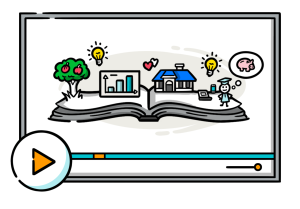Sparking an Emotional Connection with Storytelling
Complex ideas come in all shapes and sizes. From theories about time travel to the history of events leading up to World Wars, complex ideas are difficult to explain and not easy to emotionally connect with. When we try to explain such complex topics without using storytelling, it can be very easy to lose our listeners in the details of the topic. The audience can easily become confused and, in their frustration, begin to lose interest. As a result, they begin to wonder about the purpose of the explanation – or they begin to wonder why they should even be interested.
The answer is simple – use storytelling. The use of storytelling in explainer videos allows the audience to connect emotionally with the characters in the story. From beginning to end, they can follow the story and see how the character went from Point A to Point B, as well as the benefits and challenges faced along the way.
How to Use Storytelling to Create an Emotional Connection
Perhaps a rather popular example of storytelling used to explain complex topics, is the award-winning film, The Big Short. If you’ve seen the film, and don’t work in the stock market world, then you know what we’re talking about! This film took on some pretty big challenges in explaining how banking outsiders could predict the global financial crisis, while making money from the crash. In fact, many filmmakers believed it was impossible to adapt the book into a movie, due to all the technical language and complex topics inherent in the text. Using storytelling, the filmmakers essentially educated the audience on relevant topics, such as synthetic collateralized debt obligations, throughout the movie.
 You can begin to understand just how compelling storytelling truly is, in explanations and explainer videos. Should you find yourself tasked with creating an explainer video to educate your viewers about some complex topic, whether it’s in the banking or science worlds, try using storytelling! You will likely find that your audience will feel emotionally engaged with the story, and will walk away with a better understanding of that topic.
You can begin to understand just how compelling storytelling truly is, in explanations and explainer videos. Should you find yourself tasked with creating an explainer video to educate your viewers about some complex topic, whether it’s in the banking or science worlds, try using storytelling! You will likely find that your audience will feel emotionally engaged with the story, and will walk away with a better understanding of that topic.
Yet, storytelling is incredibly beneficial for all types of explanations, not just those regarding complex topics. According to John Coleman for Harvard Business Review, for example, storytelling should be used to explain your company’s history and purpose. By sharing the company’s story, consumers feel emotionally closer to that company, with an understanding of where it came from and why it was founded in the first place. Whether these are hope-filled or tear-jerking stories, powerful emotions can be conveyed with video storytelling, creating strong connections with consumers. This may not seem easy at first, but creating a public narrative will make it simpler for your consumers to understand the company’s purpose, just as it enhances explainer videos for other incredibly complex topics.
“Storytelling can be awkward and unfamiliar to many professionals, particularly if you’re sharing personal experiences. Yet the motivation for this storytelling is not self-aggrandizement, but to create a purpose and culture that others can share.”
– John Coleman, Harvard Business Review
